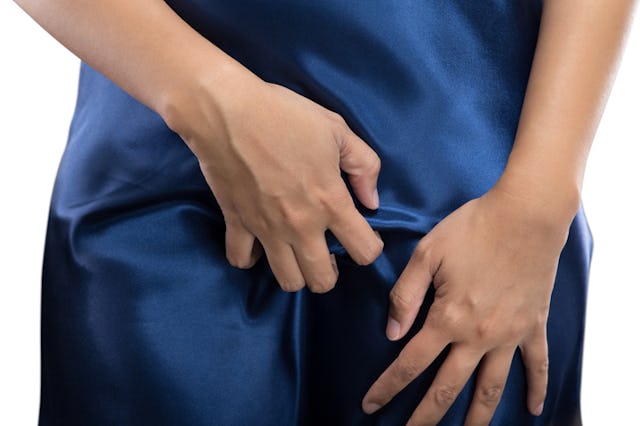Vagina Thrush Is A Common But Annoying Condition, Here's What You Need To Know

Itch, itch. Scratch, scratch. Almost everyone born with a vagina has been in itchy vagina hell at one point or another. And while not all cases of vaginal itching are attributed to yeast infections (STDs and bacterial vaginosis can cause similar itching), three out of four women will experience a yeast infection (or thrush) at one point or another, according to BBC.com. Six percent of women experience chronic yeast infections. Ughhhh.
Dr. Rautemaa-Richardson, who was a lead researcher of a new report in The Lancet about the growing prevalence of yeast infections, says that they can absolutely affect every aspect of a woman’s life and make things pretty damn horrible – especially for women who have recurrent infections.
“They say, ‘Life is hell’, ‘I can’t go on holiday because of it’ and ‘I can’t do this or that,’” Dr. Rautemaa-Richardson tells BBC.com. “Female patients have told me I saved their marriage by getting rid of thrush.”
Holy crap. As hard as it is to fathom that a marriage could potentially be ruined by a yeast infection, the few times I had one, I definitely wanted to stab my husband’s eyes out. It was mostly because I was itchy and annoyed, and envious of his non-vagina-having status.
But in all seriousness, having that itchy, burning painful feeling in your vagina – especially on an ongoing basis – isn’t just annoying. It can seriously impact all areas of your life, from engaging in normal activities, exercising, getting a good night’s sleep, and getting your sexy on.
So what exactly is a vaginal yeast infection, and how do you know if you have one? Simply put, we all have yeast (candida being the most common strain) in our vaginas. But when there is an overgrowth of this yeast, we experience all the telltale symptoms of an infection, like itching, burning, redness, pain, and that lovely cottage-cheese quality discharge.
Vaginas are prime places for yeast to happily grow because they thrive in warm, damp places. That’s also why yeast/thrush is common on boobs, especially when you are nursing. Fun times.
According to womenshealth.gov, you are more likely to get a yeast infection if you are pregnant, have diabetes, douche frequently, use hormonal birth control, have recently taken a course of antibiotics, or have a compromised immune system.
While many infections can be treated by OTC meds, most doctors recommend getting a proper diagnosis because as many as two out of three women who self-treat yeast infections actually don’t have a yeast infection at all, as womenshealth.gov explains. And when you overuse OTC yeast medications, your body becomes resistant to them, making them less effective down the road when you were to have an actual yeast infection. Good to know, right?
And if all this weren’t bad enough, according to The Lancet report, yeast infections appear to be rising each year, especially among women ages 25 to 34, most likely because of a concurrent rise in the use of hormone replacement therapy (HRT) among women in that age bracket.
That’s all we need, right? More yeast infections. Sheesh. As if women don’t have enough crap to contend with.
Dr. Rautemaa-Richardson urges all women to go to the doctor ASAP if symptoms arise, because none of us should have to put up with this kind of nonsense. And itchiness. OMG, the itchiness.
“Thrush is often thought of as an embarrassing problem women should accept, rather than a medical problem which needs to be dealt with,” says Dr. Rautemaa-Richardson. “But for millions of women, it can have a massive impact on their quality of life.”
Yep. It can be so easy for busy women – who are so used to taking care of everyone but themselves – to put off getting treatment for things like yeast infections. But seriously, you shouldn’t have to suffer for one more freaking day if you have the symptoms. Your quality of life is just as important as anyone else’s.
And here’s another burning question (see what I did there?): What about yogurt for yeast infections? Dr. Riina Rautemaa-Richardson says that, as of now, there is no good data to back up the idea of putting yogurt right there in your vagina in the hopes of the infection going away, although it could have a cooling effect, she says. So I suppose there isn’t any harm there?
Other reports have shown that consuming yogurt (or pills containing Lactobacillus acidophilus) may help change your overall flora and combat yeast infections. So go for it, right? However, if that and/or other OTC meds don’t work, get your butt (and vag) to the doctor right away.
Don’t delay. You and your vagina deserve to feel better. Scratch that (apologies for the endless puns!) — you deserve to feel fantastic.
This article was originally published on